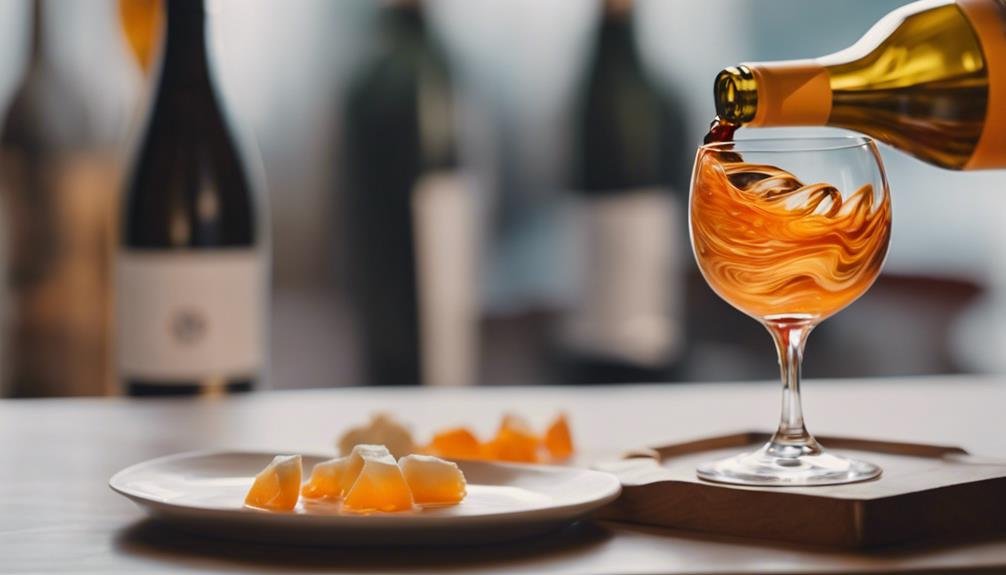Discover Austrian orange wine – exhibiting an amber hue and unique grape skin fermented flavors like citrus and nuttiness, with a tannic mouthfeel, an uncommon feature for white wines. This unconventional choice boasts elevated tannin levels akin to red wines, enhancing complexity and mouthfeel, a product of ancient winemaking methods passed down through generations. Try the 2020 Meinklang Weisser Mulatschak for grapefruit undertones, a diverse bouquet, and a harmonious palate with citrus and vanilla notes. Embrace this enthralling journey through historical traditions and flavors, best paired with shellfish or nutty cheeses for a departure from the norm.
Orange Wine Characteristics
Orange wine showcases a distinctive amber hue and unique flavors due to its fermentation process with grape skins, setting it apart from both red and white wines. This process, known as skin contact, allows the grape skins to remain in contact with the juice during fermentation, imparting tannins, color, and a complex flavor profile to the wine.
Orange wines are characterized by flavors such as citrus, jackfruit, and nuttiness, which differ markedly from the flavor profiles of red and white wines. The extended skin contact also contributes to the slightly tannic mouthfeel of orange wine, adding depth and structure to the overall drinking experience.
These characteristics make orange wine a fascinating choice for wine enthusiasts looking to explore new and unconventional flavors in the world of winemaking.
Tannin and Body Profile
With a notable presence uncommon in typical white wines, orange wines exhibit elevated levels of tannins that contribute to their distinctive body and texture. These tannins create unique sensations and add complexity to the body of Austrian orange wines. The tannins in orange wines are reminiscent of those found in red wines, providing a pleasant bitterness and a fuller mouthfeel. The body complexity of orange wines is heightened by these tannin sensations, setting them apart from traditional white wines. Below is a table summarizing the tannin sensations and body complexity of Austrian orange wines:
| Tannin Sensations | Body Complexity |
|---|---|
| Similar to red wines | Fuller mouthfeel |
| Pleasant bitterness | Unique sensations |
| Enhance body structure | Stand out from white wines |
Origin and Production Insights

Elevating the discussion to the historical roots of winemaking, the origin and production process of Austrian orange wine offer a compelling narrative of tradition and innovation intertwined.
This unique style of wine originated in Georgia, where ancient winemakers utilized qvevri for fermentation. Qvevri, large clay vessels buried underground, have been integral to the production of orange wine, imparting distinct characteristics to the final product.
While modern techniques have evolved, some Austrian winemakers still embrace these ancient methods, connecting drinkers to a bygone era. The use of qvevri fermentation not only adds historical significance but also contributes to the complex flavors and textures that define Austrian orange wine, making each sip a journey through time and tradition.
Austrian Orange Wine Example
An exemplar of Austrian orange wine, the 2020 Meinklang Weisser Mulatschak displays a mesmerizing blend of aromas and flavors that define this unique style. This wine stands out for its:
- Grapefruit Undertones: The subtle citrusy notes of grapefruit add an invigorating and zesty layer to the overall profile of the wine.
- Aromatic Complexity: With a bouquet that includes apricot, clementines, peach, vanilla, and white flowers, this wine offers a diverse and alluring olfactory experience.
- Palate Harmony: On the palate, the wine harmoniously combines citrus flavors with hints of vanilla, green tea-like tannins, and lemon notes, creating a well-balanced and textured taste sensation.
The 2020 Meinklang Weisser Mulatschak is a prime example of the intriguing characteristics that Austrian orange wines have to offer.
Final Impressions and Recommendations

In concluding the exploration of Austrian orange wine, the distinctiveness and historical allure of this style shine through, offering wine enthusiasts a truly unique and enthralling tasting experience. With its ancient origins dating back to Georgia, orange wine not only captivates the palate but also provides a glimpse into past winemaking traditions.
When considering pairing options, shellfish or nutty cheeses beautifully complement the citrusy and tannic notes found in Austrian orange wine. The complexity and depth of flavors in this wine make it a standout choice for those seeking a departure from traditional white or red wines.
Embrace the opportunity to savor a glass of Austrian orange wine for a truly distinctive and memorable tasting journey.
Frequently Asked Questions
How Does Skin Contact Affect the Color of Orange Wine?
Skin maceration during orange wine production affects the color by allowing the grape skins to remain in contact with the juice. This process extracts pigments, tannins, and flavor compounds, resulting in the unique amber hue and contributing to flavor development and oxidative winemaking for enhanced aroma complexity.
Can Orange Wine Be Aged Like Red or White Wines?
Orange wine can be aged, but differently than red or white wines. Due to tannins, aging potential varies. Tannins aid structure and flavor development. Some orange wines benefit from aging, evolving with time to reveal complex flavors and textures.
Are There Specific Regions Besides Austria Known for Orange Wine Production?
Orange wine production extends beyond Austria. Italy, steeped in winemaking tradition, and Georgia, with its ancient influence, are notable regions. Italian winemakers embrace skin-contact methods, while Georgian qvevri fermentation contributes to a diverse orange wine landscape.
What Makes Orange Wine a Suitable Pairing With Shellfish?
Orange wine's acidity and skin contact influence make it a suitable pairing with shellfish. The tannins and bold flavors stand up to the delicate flesh, creating a harmonious contrast. Consider regional differences for unique flavor profiles and aging potential.
Do All Orange Wines Have Similar Flavor Profiles to Austrian Examples?
When comparing orange wines globally, variations in flavor profiles are evident due to different grape varieties, production methods, and regional influences. Skin contact effects, aging potential, and food pairings also contribute to diverse tasting experiences.
Conclusion
To sum up, Austrian Orange Wine offers a unique tasting experience with its amber hue, robust body, and hint of bitterness. Originating from Georgia and crafted using ancient techniques, this style of wine provides a taste of history in every sip.
Its distinctive characteristics and complex flavors make it a compelling choice for wine enthusiasts looking for something truly memorable and different in their wine tasting journey.
Cheers to exploring the world of Austrian Orange Wine!